Kopp ja käe liikumine: Need annavad jõudu hüdrosilindritele, mis vastutavad ekskavaatori küna ja käe tõstmise, langetamise ja kallutamise eest.
Boomi liikumine: Need hõlbustavad ekskavaatori poomi välja- ja sissetõmbamist, võimaldades jõuda ja kaevata erinevatel kaugustel.
Kiikmehhanism: Need võimaldavad ekskavaatori ülemise konstruktsiooni pöörlemist, mis võimaldab seda keerata ja manööverdada kaevetööde tegemiseks eri suundades.
Reisimine: Need ajavad hüdromootoreid, mis liigutavad ekskavaatori rööpaid või rattaid, võimaldades neil liikuda maastikul.
Abifunktsioonid: Need võivad käivitada ka lisaseadmeid ja -funktsioone, näiteks hüdraulilisi pöidlaid, hüdraulilisi haamreid või hüdraulilisi haakeseadmeid kiireks seadme vahetamiseks.
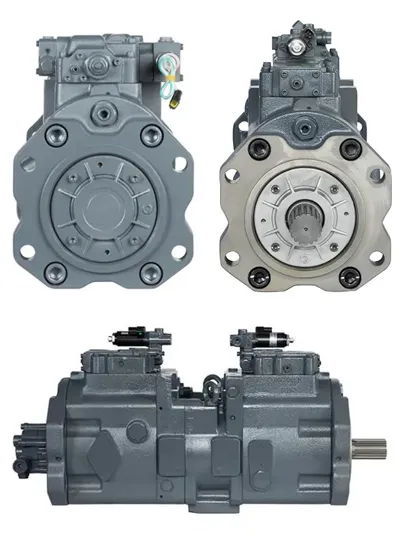
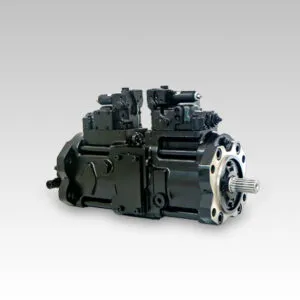
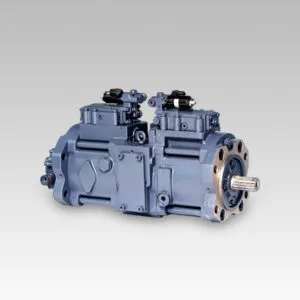
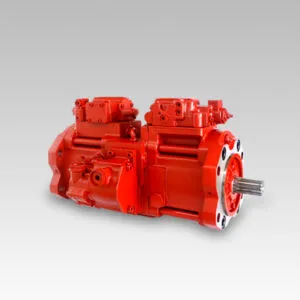
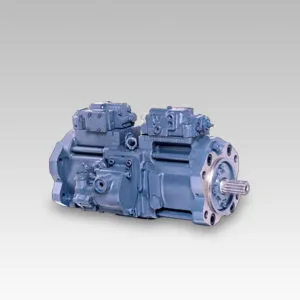
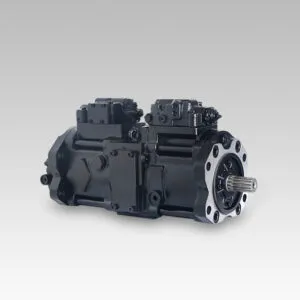
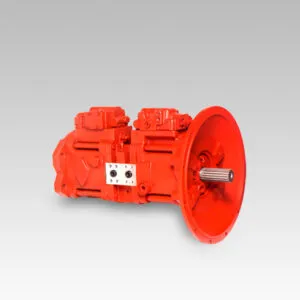
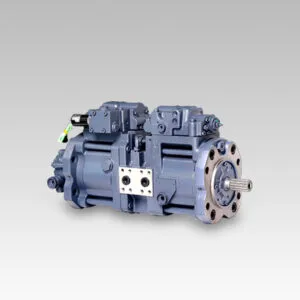
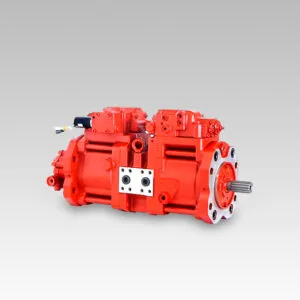
Ekskavaatori hüdraulika pump vastutab mehaanilise jõu muundamise eest hüdrauliliseks jõuks. Selle peamine ülesanne on tekitada vajalik hüdrauliline surve erinevate hüdraulikakomponentide, näiteks silindrite, mootorite ja klappide käitamiseks, mis võimaldab ekskavaatoril tõhusalt täita selliseid ülesandeid nagu tõstmine, kaevamine ja materjalide teisaldamine. Sisuliselt annab hüdropump energiat ekskavaatori hüdraulikasüsteemile, mis võimaldab tal täita mitmesuguseid funktsioone täpselt ja võimsalt.
Hüdropumba korpuse sees on paar hammasratast või kolbi, mis haakuvad omavahel, moodustades pumba korpuse sees teatava mahu. Kui hüdropumba ülekandevõlli pöörleb, pöörleb hammasratas või kolb vastavalt, muutes seeläbi pumbakambri mahtu.
Kui pumbakambri maht suureneb, väheneb rõhk pumba sees ja hüdraulikaõli siseneb pumba kambrisse imipordi kaudu; kui pumbakambri maht väheneb, suureneb rõhk pumba sees ja hüdraulikaõli voolab pumba kambrist välja survepordi kaudu.
Selle tööpõhimõtte abil saab hüdrauliline pump pidevalt hüdraulilist õli sisse ja välja imeda, moodustades stabiilse hüdraulilise energia
Ekskavaatorite hüdraulika pumba rikke tavalised märgid on hüdraulilise võimsuse kadumine, ebatavalised müra, vedeliku lekked, ebakorrapärane töö, ülekuumenemine, suurenenud kütusekulu, saastunud hüdrauliline vedelik ja hoiatustuled või häiresignaalid.
Väiksemates ekskavaatorites, näiteks mini- ja kompaktekskavaatorites, kasutatakse sageli hammas- või tiivapumpasid nende lihtsuse, kompaktsuse ja kuluefektiivsuse tõttu. Need pumbad pakuvad piisavalt hüdraulilist võimsust kergete ja mõõdukate kaevamis- ja tõstmisülesannete täitmiseks, mida tavaliselt täidavad väiksemad ekskavaatorid.
Keskmise ja suure suurusega ekskavaatorites, sealhulgas tavalistes ja rasketes ekskavaatorites, kasutatakse tavaliselt kolbpumpasid. Kolbpumbad on tõhusamad, usaldusväärsemad ja suudavad tekitada suuremat rõhku, mistõttu sobivad need raskete kaevetööde, tõstmise ja muude nõudlike ülesannete täitmiseks.
Lisaks võivad paljud kaasaegsed ekskavaatorid, olenemata suurusest, kasutada eri tüüpi hüdropumpade kombinatsiooni, sealhulgas muutuva töömahuga pumbad täpseks kontrollimiseks ja fikseeritud töömahuga pumbad püsivaks vooluhulgaks.
Ekskavaatori vigase hüdropumba väljavahetamine võib olla keeruline ülesanne ja nõuab tavaliselt professionaalset hooldust. Hüdraulikasüsteemid on ekskavaatorite keerulised ja kriitilised komponendid ning pumba vahetamisel võib ebaõige paigaldamine või käsitsemine põhjustada edasisi kahjustusi või talitlushäireid. Professionaalsetel tehnikutel on vajalikud teadmised ja spetsiaalsed tööriistad, et diagnoosida hüdraulika pumba probleemid täpselt ning tagada uue pumba nõuetekohane paigaldamine ja kalibreerimine. Püüdmine pumba väljavahetamiseks ilma vastavate teadmiste ja kogemusteta võib põhjustada ohutusriski, väiksemat jõudlust või täiendavaid remondikulusid. Seetõttu on soovitav pöörduda ekskavaatorite hüdropumba vahetamiseks professionaalse hoolduse poole.
Teie ekskavaatori hüdropumba kontrollimise ja hooldamise sagedus sõltub mitmest tegurist, sealhulgas tootja soovitustest, seadme vanusest ja kasutamisest ning töötingimustest. Üldjuhul on soovitatav kontrollida ja hooldada hüdropumpa osana seadmete tavapärasest hooldusest, mis võib toimuda korrapäraste ajavahemike järel, näiteks iga 250-500 töötunni järel või vastavalt ekskavaatori hooldusjuhendis sätestatule. Lisaks sellele on oluline jälgida regulaarselt hüdraulikasüsteemi tööd ja tegeleda viivitamatult igasuguste ebatavaliste müra, lekete või vähenenud tõhususe märkidega. Ennetava hooldusgraafiku järgimine aitab vältida kulukaid seisakuid ning pikendab hüdraulika pumba ja muude kriitiliste komponentide kasutusiga.
Hammasrattapumbad:Lihtne ja kuluefektiivne.Kasutatakse väiksemates ekskavaatorites.Mürarikas töö.
Vaneerpumbad:Tõhusam ja vaiksem.Sobib keskmise suurusega ekskavaatoritele.Keskmise rõhu rakendused.
Kolbpumbad:Kõige tõhusam ja mitmekülgsem.Kasutatakse suurtes ekskavaatorites.Kõrgsurvevõimekus.
Muutuva töömahuga pumbad:Reguleeritav vooluhulk ja rõhk.Energiatõhus.Kasutatakse muutuvate nõudmistega ekskavaatorites.
Fikseeritud töömahuga pumbad:Konstantne vooluhulk.Lihtne konstruktsioon ja madalamad kulud.Sobib pideva hüdraulilise võimsuse vajaduste rahuldamiseks.
Ekskavaatori hüdraulilise pumba süsteemi tõhususe suurendamiseks keskenduge regulaarsele hooldusele, optimaalsele vedeliku valikule ja rõhulanguse vähendamisele. Veenduge, et komponendid on õigesti dimensioneeritud, ja kaaluge nende ajakohastamist tõhusamaks. Muutuva kiirusega ajamite ja koormustundlike süsteemide rakendamine võib kohandada pumba võimsust nõudlusele, samas kui õige operaatorite koolitus võib vähendada tarbetut tühikäiku. Jälgige süsteemi jõudlust, et tuvastada ja kõrvaldada ebatõhusus kohe, mis viib tootlikkuse paranemiseni ja tegevuskulude vähenemiseni.
Optimaalse jõudluse tagamiseks on soovitatav teostada ekskavaatori hüdropumba hooldust vastavalt tootja juhistele. Tavaliselt hõlmab see regulaarset kontrollimist ja hooldust kindlaksmääratud ajavahemike järel, mis võivad erineda selliste tegurite, nagu töötingimused, kasutussagedus ja keskkonnategurid, alusel. Üldine ajakava hõlmab rutiinseid kontrolle plaaniliste hooldusintervallide ajal, näiteks iga 250-500 töötunni järel või igal aastal, ning sagedasemat kontrollimist lekete, saastumise või ebanormaalse toimimise märkide tuvastamiseks. Järjekindla hooldusgraafiku järgimine aitab tagada ekskavaatori hüdraulilise pumba süsteemi pikaealisuse ja töökindluse.